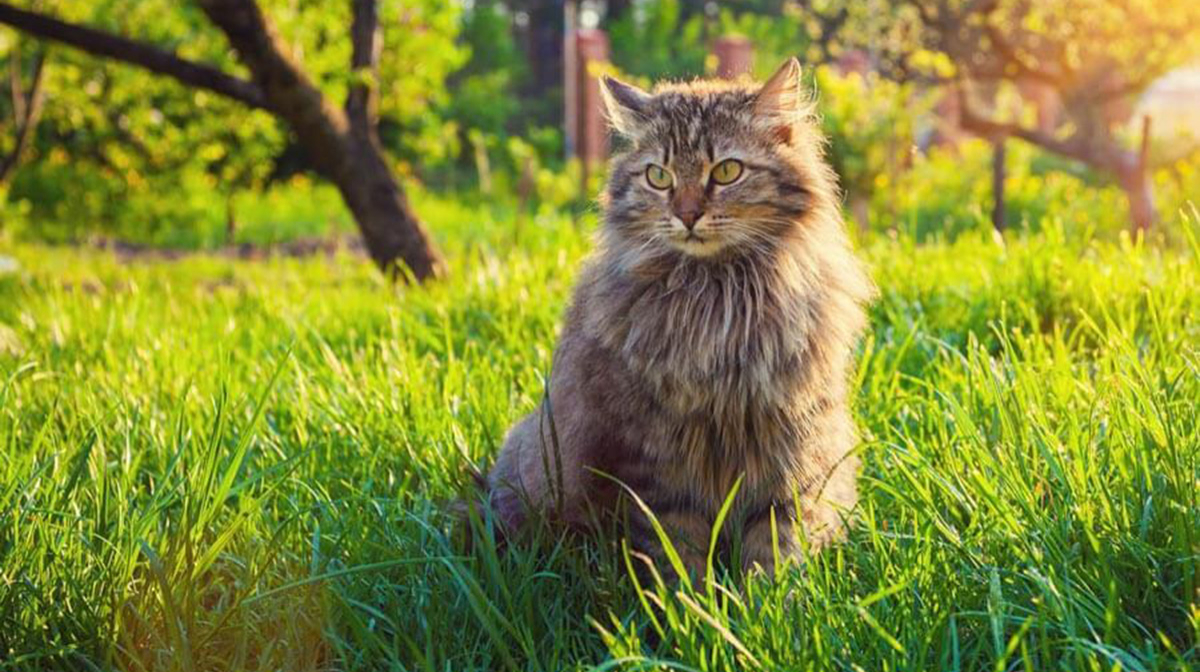
Cats are one of the most popular pets and some of our closest companions. Their independent characters not only make them low-maintenance pets; but challenge us to read their behaviour so we can best provide for them. Despite what some may think, cats are very expressive companions. James Wellbeloved takes a look at some of the most common behaviours your cat is likely to exhibit.
SAYING HELLO
Cats have a few greeting methods, depending on how comfortable they feel around you. To start, approaching you with their tail pointing up to the sky is a typical friendly greeting and means they want to say hello! Next, rubbing their head, body and tail against your leg is another classic feline greeting – if you get a gentle headbutt that indicates extra affection and trust. Cats have scent glands on their head and ears, so if your cat rubs their cheeks and sides against you, this is their way of investigating your smell and then rubbing their own scent onto you.
TO STROKE, OR NOT TO STROKE; THAT IS THE QUESTION
Perhaps your cat has a favourite spot to roll on its back and expose its tummy. If so, chances are it’s feeling nice and relaxed. It could in fact be a demonstration that they trust you and feel comfortable in your presence, as presenting the belly shows their vulnerability. However, cats are very aware of their surroundings and likely to change mood at the slightest stimulus. So, just because a kitty is on their back, doesn’t mean they’re inviting you to tickle them. Depending on your cat’s character, they may have areas of their body that they do not appreciate being touched, such as their tummy. This is just one behaviour, but there are some more general signs of comfort or anxiety. Relaxed muscles, forward-facing ears and constricted pupils are all signs of calm. Conversely, if their muscles are tense, the body is low to the ground, and their pupils are dilated then something in the vicinity is making them feel threatened. Speaking of pupils…
EYES ARE THE WINDOW TO THE SOUL
In the animal kingdom, closing your eyes is a sign of trust. It means you’re in an environment where you can let your guard down. The next time your cat gives you an unnerving stare, only to slowly blink their eyes, slow blink back at them, because they just told you how comfortable they feel with you. Really comfortable cats will even lick their owners’ hands or faces!

Many cats also maintain their prolonged stare while in hunting mode. When in this state of high attention, their brain is telling them to pounce at any movement. If the objects they happen to be staring at are your fingers or toes, it’s best to keep them still. A cat’s pupils can also tell you what they may be feeling. Wide pupils can mean fear or anxiety – as your cat tries to take in everything around them. Dilated pupils, when combined with purring and a relaxed body, can convey contentment or pleasure. However, your cat’s pupils shrinking can also be a sign of anger or fear, especially when paired with flattened ears and a tucked-in tail. Speaking of tails…
AN EMOTIONAL TAIL
Eyes aren’t the only way to get a sense of what your cat is feeling – a cat’s tail is very expressive. A high tail, if not too tense, denotes confidence and familiarity. This is doubly so if your cat decides to cuddle you with their tail, as curling it around you means they are in an affectionate mood. A high, bushy tail can mean a cat is scared, especially if their back is arched or low to the ground, but this can also be a sign of excitement. Always take note of the cat’s surroundings so you can understand if the bushy tail is anxiety or excitement. Bear in mind that cats and dogs tend to tuck their tails in between their legs when they are scared. If your cat’s tail is pointing towards the ground, there’s a good chance they are frightened, while a wagging or twitching tail means that your cat is irritated or upset and should be left alone. Of course, there is one more method of communicating that is more reliable than movement, eyes and tails: speaking!
CAT GOT YOUR TONGUE?
As helpful as body language can be, nothing tells you better that your cat is comfortable than their soft purring as they settle in your warm lap. They might even start purring beforehand, as well – a sure sign that they’re craving some of your attention, while high-pitched gurgling is the sign of a friendly kitty that wants to talk your ear off.

Cats also meow to communicate with us. A short single meow is usually used as a casual greeting, whilst lots of meowing or trilling indicate your pet is happy to see you! Longer, mid-pitch meows can be requests for attention or food, while high-pitched meows indicate shock or pain. Low meows are a sign that your cat may be ready to fight, especially when combined with growling, so it’s a good idea to leave them be until they are more relaxed. Growling, hissing and spitting are the common sounds of any pet that is upset, anxious, or feeling threatened, so be sure to give them some space if they sound aggressive towards you. It’s important to be aware that whilst purring usually has positive connotations, it can sometimes be a sign of pain – so pay close attention to your cat’s vocalisations just in case. If you like to talk to your cat, then there’s a chance they might understand you! Cats can understand their owner’s voices and may even recognise several different words, aside from their name. They also respond to different tones and volumes, so try to use a calm, gentle voice when speaking to them. It’s important to use consistent tone of voice, facial expressions and gestures to avoid confusing your cat.
TIPS FOR UNDERSTANDING YOUR CAT
There are several social cues which will help you further understand cat body language and behaviour. These are some of our top suggestions:
If your cat gently bites you whilst playing, they are probably telling you they have had enough
If your cat growls at you when you stroke them or pick them up, they do not want to be disturbed – especially if they are sleeping or eating
If your cat runs off when you greet them, you likely moved too quickly. When greeting your cat, take things slowly and let them approach you
If your cat doesn’t show you the typical signs of affection mentioned here, don’t worry. All cats are different and show their feelings in different ways
NO-ONE KNOWS YOUR PET LIKE YOU
These are the most common traits of cat behaviour, but every cat has their own way of communicating. The top piece of advice we can offer is that cats are each special in their own way, including their behavioural quirks. No-one knows your cat better than you, so the best way to read your kitty is to spend time with them, play with them and learn what gets them excited and what makes them anxious. Ultimately, it’s learning to love and understand your cat for their individual nature that creates the strongest bond between you both.

Related Articles








